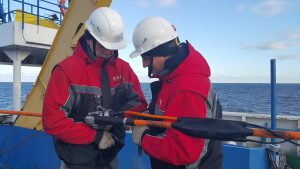Differential-normalized method of electical-prospecting (DNME), developed by SGRPC company, allows mapping the distribution of the electrical resistivity of the geological environment and polarizability of rocks. The predominant prospecting indicator is a number of anomalies of the induced polarization occurring in the areas of distribution of halos of dispersion over the hydrocarbon deposits.
The possibility of simultaneous obtaining information on the geoelectric and polarization properties of the medium makes it possible to significantly improve both the quality of the geological interpretation and the informative value of the results obtained, in contrast to most methods where the prediction is based only on the electrical resistivity parameter.
This method has been successfully tested in diverse geoscience conditions including prospecting under halogen- and-carbon-bearing low-conductivity shield with widespread development of trap magmatism, in the areas of ancient and young platforms, continental depressions, fore deeps, in freshwater reservoirs and on the shelf of inland waters and marginal seas.
 |
 |
The results of the method are not confined by trap type (structural, non-structural) and reservoir type (terrigenous, carbonate).
DNME is considered, first of all, as an element of the complex survey with seismic prospecting and logging.
Advantages of DNME method:
- High probability of detection of the fluid saturation of potential hydrocarbon traps - according to independent expert estimates, the success rate of DNME + logging + seismic survey is more than 85%.
- Significant risk reduction for the location of deep drilling oil-gas wells.
- Significant reduction in costs of "dry" wells drilling. The method has been proved efficient in reducing drilling risks during oil and gas exploration in all oil and gas provinces of the Russian Federation and abroad.
- Possibility of carry out operations in any conditions: on land and at sea (in transition, shallow water and deep water zones), in diverse geological and geophysical conditions. A towed underwater system (TUS) has been specially developed by SGRPC for DNME survey in deep water.
- DNME operation is 2-3 times cheaper than those applying CSEM methods. The productivity of DNME averages 45-60 km/day, which is higher than CSEM performance on average by 20-30 km/day or by 35%.
Map
